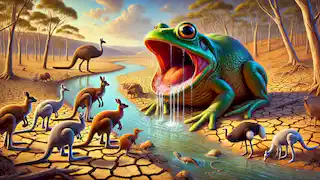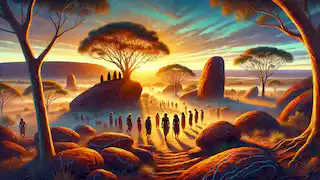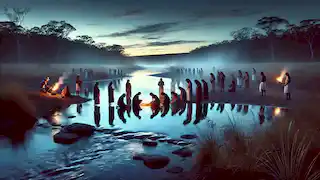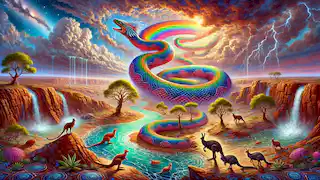In the vast landscape of Australia, before time as we know it began, the world was a barren, empty place. There were no rivers, no trees, and no living creatures—just endless stretches of land and sky. This was the Dreamtime, a period of creation when the Ancestral Spirits roamed the earth, shaping the world as they traveled. These spirits were neither human nor animal, but a combination of both, beings of immense power who brought life and form to the land, the skies, and the seas. This is the story of the Dreamtime, passed down through generations of Aboriginal peoples, teaching them about their origins, the sacredness of nature, and the intricate relationships between all living things. In the beginning, the Earth lay quiet, asleep beneath the vast expanse of the sky. Nothing moved; there was no sound, no wind, no life. But deep beneath the surface, the Ancestral Spirits were stirring. They had been dormant for a long time, but it was now time for them to emerge and begin their work of creation. The first spirit to awaken was the Rainbow Serpent, a mighty being who slithered across the barren land, carving deep valleys, winding rivers, and tall mountains wherever it went. As it moved, the earth began to tremble, and with each twist and turn of the serpent's body, the land took shape. The Rainbow Serpent's scales shimmered with every color, casting light across the dark and empty world. From this serpent, rivers flowed, filling the once dry land with water, giving life to the earth. The Rainbow Serpent was not alone in its task. Soon, other Ancestral Spirits awoke and joined in the great work of creation. Some traveled with the wind, bringing rain and storms, while others moved across the sky, giving birth to the sun and stars. These spirits brought with them the first plants and animals, breathing life into the trees, flowers, and creatures that would come to populate the earth. As the world grew more vibrant and alive, the Ancestral Spirits continued their journey, spreading out across the land. Each spirit had a unique role to play in shaping the world, and their movements became the stories and laws that the Aboriginal people would follow for generations to come. With the earth now filled with rivers, mountains, and trees, the spirits turned their attention to creating life. They breathed their power into the animals, bringing them into existence. Kangaroos leaped across the plains, emus ran swiftly across the grasslands, and crocodiles lurked in the waters. Each creature was given a role, a place within the natural world, and was taught how to live in harmony with the land. But the Ancestral Spirits were not finished. They knew that the earth needed caretakers, beings who could understand and respect the world they had created. So, from the clay of the earth, they formed the first humans. These early people were gifted with knowledge and wisdom, taught the laws of the land, and given the responsibility to care for it. The spirits showed the humans how to hunt, gather food, and live in balance with nature. They were taught the sacred songs and stories of creation, and these stories were passed down from one generation to the next. The Aboriginal people came to understand that everything in the world was connected, that the earth, the sky, the animals, and the people were all part of a great cycle of life. As the humans spread across the land, they began to form their own tribes and communities. Each group had its own sacred places, where the Ancestral Spirits had left their mark. These places were revered and respected, for they were seen as the homes of the spirits, and to harm them would bring great misfortune. The Aboriginal people believed that the spirits were always watching, even after they had disappeared from sight. The spirits lived on in the land, in the trees, the rivers, and the animals, guiding the people and protecting the world they had created. The Dreamtime was not just a time of creation; it was also a time when the laws of the land were established. The stories of the Dreamtime, known as the Dreaming, were more than just tales of the past—they were the foundation of Aboriginal law and culture. Every mountain, river, and animal had its own Dreaming story, which explained how it came into being and what its purpose was in the world. One of the most important Dreaming stories was that of Tiddalick, the giant frog. Tiddalick was a greedy creature who drank all the water in the land, causing a great drought. The other animals, desperate for water, came together to find a way to make Tiddalick release the water he had swallowed. After many failed attempts, they discovered that making the frog laugh was the only way to make him spit out the water. The tiny eel finally succeeded by twisting and wriggling into strange shapes, causing Tiddalick to laugh so hard that he released the water, restoring life to the land. Stories like Tiddalick's were not just entertaining—they taught important lessons about greed, cooperation, and respect for nature. The Dreaming stories were passed down orally, from elders to children, and were often accompanied by songs, dances, and ceremonies. These stories formed the core of Aboriginal spirituality, teaching the people how to live in harmony with the world around them. Each tribe had its own set of Dreaming stories, and these stories were deeply tied to the land. To harm or neglect the land was to break the sacred laws of the Dreaming, and the consequences could be disastrous. The Ancestral Spirits did not disappear after the creation of the world; they remained a vital part of Aboriginal culture and spirituality. The spirits were believed to live on in the natural world, in the rocks, trees, and rivers. They were also present in the ceremonies and rituals that the Aboriginal people performed, keeping the connection between the past and the present alive. One of the most sacred rituals was the corroboree, a ceremonial gathering where the people would sing, dance, and tell stories from the Dreaming. These ceremonies were a way of honoring the ancestors and the spirits, ensuring that the laws of the Dreaming were upheld. The corroborees were also a way of passing down knowledge to the younger generations, ensuring that the Dreaming stories would never be forgotten. The ancestors were also believed to guide the people in their daily lives, helping them make important decisions and ensuring that they followed the laws of the land. Aboriginal people believed that the spirits were always watching, and that they would intervene if the laws of the Dreaming were broken. These beliefs were central to Aboriginal life, influencing everything from the way they hunted and gathered food to the way they treated the land and each other. The connection to the ancestors was a reminder that the people were part of a larger cycle of life, one that began in the Dreamtime and continued through every generation. To the Aboriginal people, the land was more than just a physical place—it was a living entity, imbued with the spirits of the ancestors. The land was sacred, and every part of it had a meaning and a purpose. The mountains, rivers, and trees were all connected to the Dreaming stories, and to harm the land was to harm the ancestors themselves. The Aboriginal people believed that they were the custodians of the land, entrusted with the responsibility of caring for it and preserving it for future generations. They understood that their survival depended on the health of the land, and they developed a deep respect for nature that was reflected in their everyday lives. For example, when hunting animals, the Aboriginal people would only take what they needed, ensuring that the species could continue to thrive. They would also perform ceremonies to thank the spirits for providing them with food, recognizing the interconnectedness of all life. This deep connection to the land was one of the reasons why the arrival of European settlers was so devastating to the Aboriginal people. The settlers did not understand the sacredness of the land, and their actions—such as clearing forests, building towns, and fencing off land for farming—were seen as a violation of the laws of the Dreaming. For the Aboriginal people, this was not just a loss of land—it was a loss of their connection to the ancestors and the spirits that had created their world. Despite the challenges they have faced, the Dreaming stories and the beliefs of the Dreamtime remain a central part of Aboriginal culture today. These stories continue to be passed down through generations, connecting the past to the present and ensuring that the wisdom of the ancestors is never forgotten. In modern Australia, the Dreaming stories are not only a source of spiritual guidance—they are also a way of preserving the rich cultural heritage of the Aboriginal people. Efforts have been made to record and document these stories, ensuring that they will continue to be shared with future generations. Aboriginal art, music, and dance continue to be inspired by the Dreamtime, serving as a reminder of the deep connection between the people and the land. These traditions are not just relics of the past—they are a living, breathing part of Aboriginal culture, constantly evolving while staying true to the ancient laws of the Dreaming. The Dreamtime teaches us that everything in the world is connected, that we are all part of a larger cycle of life. It reminds us to respect nature, to live in harmony with the world around us, and to honor the spirits of those who came before us. The stories of the Dreamtime are not just stories—they are a way of life, a guide for how to live in balance with the world. The Dreamtime is more than just a myth or a story; it is a fundamental aspect of Aboriginal identity and culture. It explains the origins of the world, the creation of life, and the laws that govern the natural world. The Dreaming stories are a reminder of the sacredness of the land, the importance of living in harmony with nature, and the responsibility that each generation has to protect the earth for those who will come after them. Through the stories of the Dreamtime, we learn that the world is alive with the spirits of the ancestors, that the land is sacred, and that everything in the world is connected. These lessons are as relevant today as they were thousands of years ago, reminding us of the importance of respect, balance, and the deep connection between all living things. As we listen to the stories of the Dreamtime, we are reminded that we are all part of a larger story, one that began in the ancient past and continues to this day. And as long as these stories are told, the Dreamtime will live on, a testament to the enduring power of the Aboriginal people's connection to the land and the spirits of their ancestors.The Beginning of Creation

The Emergence of Life
The Dreaming Stories

The Role of the Ancestors
The Importance of the Land

The Dreamtime Today
Conclusion

The Story of the Dreamtime
Reading Time: 10 min

About Story: The Story of the Dreamtime is a Myth Stories from australia set in the Ancient Stories. This Descriptive Stories tale explores themes of Nature Stories and is suitable for All Ages Stories. It offers Cultural Stories insights. A timeless Aboriginal creation myth that reveals the origins of life and the sacred connection to the land.
















